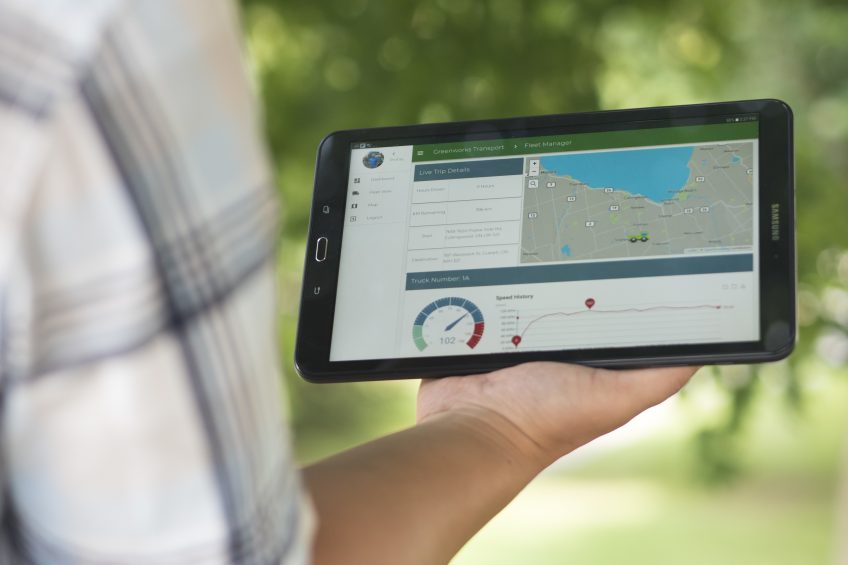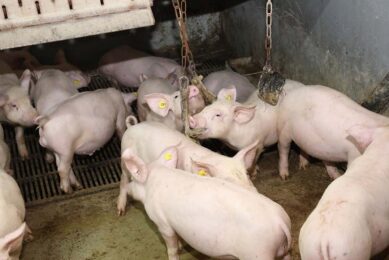New tool helps monitor pig welfare during transport

Pigs and other livestock are travellers these days, being brought from one farm to the other – or to the slaughterhouse. For various reasons, it’s imperative to make sure that the animals are well during transport as well. A new tool can help to oversee and respond quickly should conditions change.
Transport represents a point in a farmed animal’s life when many experts say welfare is most at risk. “There are greater variables, such as weather and temperature, when livestock are in transport,” notes Canadian Animal Health Coalition executive director Mark Beaven, “and transporters need to pay extra careful attention to welfare issues.” The coalition is a non-profit organisation that works to identify farmed animal health and welfare solutions, influence government policy and more.
Like other animal welfare topics such as battery cages for laying hens and gestation crates for sows, transport has received a great deal of attention in the media. Indeed, one incident involving pig transport in Canada made headlines around the world in 2015, and was described in Canadian national newspaper The Globe & Mail as “a symbol of the escalating tensions between the animal-rights movement and the meat industry.”
In the incident, a woman in Ontario was charged with criminal mischief for giving water to pigs in transport trucks stopped in traffic on a hot summer day. She was acquitted of the charge last year, and was described as ‘an international animal-rights star’ in The Globe & Mail.
It’s no surprise then, that technology to prevent welfare issues during transport is being developed. A patented Canadian real-time alert system is just being launched by the makers of Be Seen, Be Safe geo-fencing real-time farm visitor tracking and outbreak biosecurity control system.
Quick reference tool
Tim Nelson, president & CEO of Be Seen Be Safe, says the idea for the system came to him a few years ago when he was working for the Poultry Industry Council in Canada, during the design and delivery of a quick reference tool to help producers decide if chickens should be transported. “It occurred to me at the time that the decision regarding bird condition and transport really rests with the producers,” he explains, “and it’s the last time producers have any control over the quality of their product that they have spent weeks nurturing and producing and years in establishing a system in which to grow those birds.”
Mr Nelson adds that “the same is true for pretty much all livestock. When I worked with cattle, it was broken legs, with pigs it’s poor quality meat and heart attacks – and these things happen to perfectly healthy animals which should theoretically be able to withstand transport. I looked at EU – same story. I looked at USA – worse.”
Another part of Nelson’s thinking was that transport is the only place where livestock management is exposed to the general public and it should therefore be as good as possible as that’s a point where activists focus. “I wondered if it was possible to fit trucks with monitors that would warn the drivers and logistics supervisors of impending problems so that they can make changes to avert welfare disasters,” he says, “or at the very least put the receiving processing plant on notice that a potentially-compromised load is coming in, “so they can organise quick unloading, lairage facilities on stand-by and so on.”
Full environmental control
Mr Nelson notes that in the EU, trucks are now being developed which are fully environmentally controlled, but they are very, very expensive. “However, there are millions of transport vehicles around the world that could be upgraded to monitor conditions and if the monitoring connects through an IoT (Internet of Things) device to climate control devices (misters, fans, baffles to guide wind, etc.), the system could control environmental conditions as well,” he explains. “Working with my business partner Joel Sotomayor and his brilliant young team, it became clear that there are technologies available that can be used to not only to monitor and send alerts, but also to utilise IoT devices to control environment conditions.”

Sensor enabling to make better decisions
The result is Transport Genie (TG), an innovative sensor that enables livestock transport managers and drivers to make better decisions in relation to trailer environmental conditions, set up automated systems to adjust conditions when they approach a threshold) and to track data over time. TG sensors currently monitor humidity and temperature, but could in future also track things like CO2 level and acceleration/braking. The development of TG was partly supported through the Accelerating Innovative Research programme through the Ontario Ministry of Agriculture, Food and Rural Affairs. TG was presented at the Ontario Pork Congress in June, and it will be presented at the World Poultry Tech Conference in Atlanta, GA, United States, this November. Other presentations will follow.
Mr Sotomayor notes that the technology can be used for all livestock species, “but we suspect that there will be slight differences because the animals themselves are different. That is also another reason why we want to partner with researchers to make sure that we have the right amount of sensors available in the trailer. We suspect that larger animals may require more sensors because we will need them to create a ‘mesh network’ to transfer the data properly.” Mr Sotomayor says he and his team will wait for more data and then finalise their sensor design.
Research using the system is also being done to track temperature and humidity in barns and in pastures and on the effect of heat in beef cattle.
Trespass Tracker The maker of Be Seen, Be Safe and Transport Genie is also commercialising a web-based farm security system called Trespass Tracker. Farmers are provided with instantaneous alerts when cameras pick up trespassers via smart phone. Planning of a large trial of the tech this fall is being finalised with a US poultry company. The website will be up soon. |
Conducting rigorous field tests
Earlier this year, Luckhart Transport in Sebringville, ON, Canada, approached TG to trial the technology (the firm transports all types of livestock), which has been welcomed by TG in order to conduct rigorous field tests. Luckhart co-owner and vice president Angie Luckhart had read a news story on TG and immediately contacted the firm.
“We are interested in doing the trial because we are extremely passionate about humane animal transport,” she explains. “We have numerous trailers in our fleet that offer humane transportation features, such as fans for forced ventilation, water misters to keep animals cool and water drinkers. So naturally, this is just another piece to the puzzle, another way we can be confident that the animals are comfortable in transit.”
Ms Luckhart says they have been interested in adding temperature sensors to their trailers for a few years now, but we weren’t able to find anything that suited their needs. “Real time communication is the key and what has made us so interested in TG,” she says. “It will also help us gather data on how our humane trailers are working. When the temperature rises in the trailer, we will be able to have data showing how quickly the fans and misters change the temperature within the compartments.”
It’s also imperative for biosecurity reasons, Ms Luckhart notes, that livestock trailers are properly sanitised. “The TG sensors will also ensure that all areas of the trailer are heated to the proper levels to kill any pathogens,” she explains. “Transport Genie is a multi-purpose system as far as I am concerned.”

Extensive use
Looking forward, Mark Beaven, of the Canadian Animal Health Coalition, predicts that use of TG will be extensive. “I see the vast majority of transporters taking advantage of the technology in short order,” he says. “Proof of this is in the fact that the few transporters that I have spoken to about it are all excited and supportive of the technology.” He believes the development of technology like TG demonstrates that the agricultural industry is concerned with the welfare of livestock and poultry and that the industry continues to innovate on that front. “It’s also satisfying,” he says, “to see that Canada is leading the world in this regard.”
 Beheer
Beheer








 WP Admin
WP Admin  Bewerk bericht
Bewerk bericht